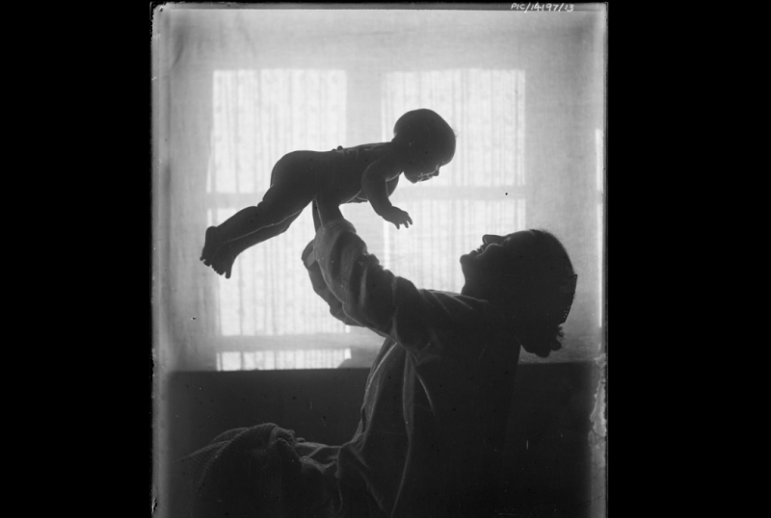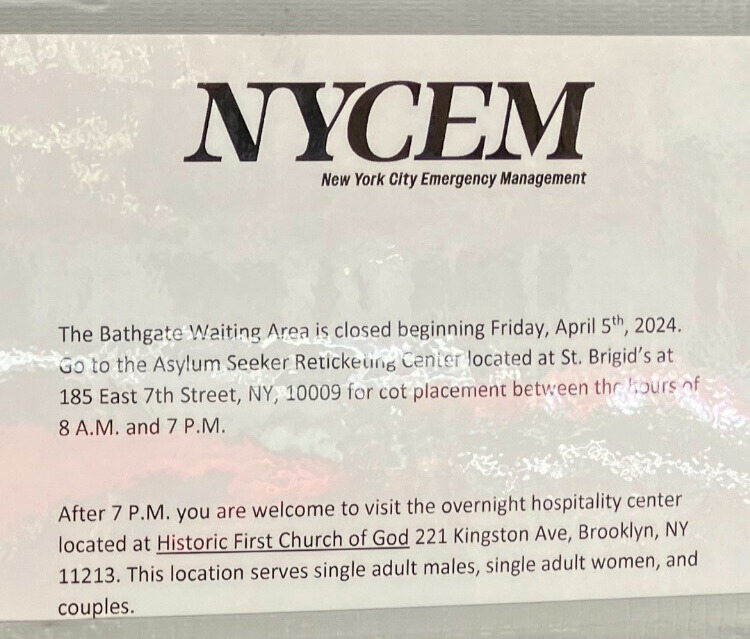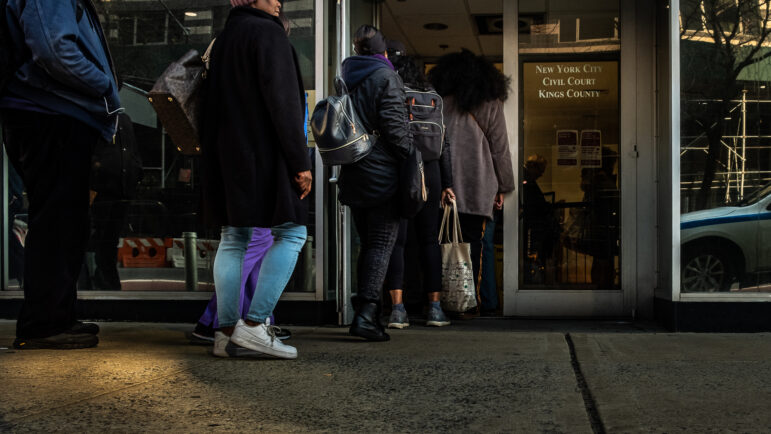
At the height of the pandemic, away from advocate’s oversight, New York State passed a bill legalizing commercial surrogacy in a manner “closed to the public…decided in back rooms”– a bill that could have waited until we weren’t overwhelmed keeping ourselves, our families and our communities alive.
It was passed without the women, whose lives will be most imperiled, being central to the discussion – in particular those women without race or economic clout, or connections to the political class.
New York State already offers altruistic surrogacy to women choosing to be surrogate mothers who have decided they are able to do so freely, and fully desire to.
Regardless of opinions on this bill, to guarantee the informed consent and aware evaluation by the governed, this law should be repealed, and local state-wide public hearings should be held with those most impacted invited to weigh in.
 CityViews are readers’ opinions, not those of City Limits. Add your voice today!
CityViews are readers’ opinions, not those of City Limits. Add your voice today!
Real choice is complex in an unfair world. Few women escape the pressure to self-sacrifice when entire economies (and families) depend on women’s unpaid/poorly paid “essential” labor to meet the basic needs of humanity. Many women become disproportionally impoverished as life goes on and too often land in old age in a merciless marketized “care” system.
Given the risks of pregnancy/egg extractions, incentivizing a woman in financial need to care less for herself than for those wishing to parent a genetically related child is at least worthy of robust discussion.
The health dangers associated with commercial surrogacy exceed the usual risks that cme with pregnancy and childbirth. These include preeclampsia, heart failure, stroke, cesarean section, subsequent pregnancy complications, ovarian hyperstimulation syndrome, potential complications of abdominal pain, blood clots and in rare cases, death.
Women are already besieged simply for having a female body–prenatally and into old age. Our bodies are fine, sexism isn’t. It’s enmeshed within larger systems of exploitation and absorbed, regardless of any individual man’s stances. It’s woven into societies, a prerequisite for sexual harassment, abuse, exploitation, rape, domestic violence, femicide, body shaming, male preference, forced sterilizations, denial of reproductive health access, and more.
Our bodily sovereignty is always in question.
Girls are primed to absorb male damage and to “go second” on behalf of others. In societies that condone or endorse an ethos of taking advantage of others, the combination shapes the erasure of a vibrant female self.
Even if we personally elude the worst, no girl avoids growing up in a world with an unspoken requirement to be at the behest of males, especially those who have financial, age, caste, class, race, origin country, heterosexual, and/or social status dominance.
In the U.S. we cling to a belief in our freedom of choice but rely on the un-chosen sacrifice by the many, and the avoidance of it by the few. The consequences are largely absorbed by women, people of color, wage workers, immigrants, the altruistic, and/or the poor (as the pandemic made visible).
We all have to make the best choices we can, with existing options that are always narrowed by oppressions. That’s one reason never to second guess how any individual woman or girl survives sexism. Survival is a victory that not all women or girls get to celebrate.
But when a state seeks to enshrine those individual “choices” (whether personal wants or necessary survival strategies) within law, that requires a higher bar, one that considers the impacts to the larger community.
If a law colludes with, intensifies, or cultivates conditions that could further entrap, risk and exploit those with no institutional power to end their systemic exploitation, society has an obligation to refuse.
We are long overdue in basing our collective lives on our collective wellbeing. In our current environment, with the ubiquity of internalized sexism and structural male domination along with a severe and punishing market system, instituting commercial surrogacy is unconscionable. It coldly calculates creating the conditions whereby a woman is paid to discount her own life to enhance someone else’s and provide profit for others.
Racism, sexism,immigration status, LGBTQ oppression, ageism and poverty all play and have played grievous, imbalanced, irrational roles in who gets to parent, who gets to have a parent, who gets to survive to be a parent/child, whose child is taken from them, whose parents are taken from them, and more.
Unequivocally, oppression should have no place in deciding anything about who becomes or stays or survives to be a family.
In effect, New York just unleashed another resource extraction industry with entire networks of hospital systems, lawyers and other profiteers–abetted now by the state. The resource being extracted is a generation of younger women in a time of rising college debt and no jobs. Commercial surrogacy has been outlawed in much of the world. Yet Global Market Insights still sees growth potential: $27.5 billion in 2025.
Some wish to end the practice of surrogacy, including altruistic surrogacy. Some defend commercial surrogacy as an antidote to oppression. Others are indignant that their struggle for liberation is now used in defense of the exploitation of others, for the well-off, and/or for profiteers. As Gary Powell has said, it’s “a hijacking of the gay rights movement by the multi-billion dollar Big Fertility industry . And as Assemblywoman Deborah Glick has observed, “considering the money involved…This is clearly a problem for the extraordinarily well-heeled.”
It may be tempting, if you have the means, to try to buy a way out of life’s heartaches, out of oppression–an impossible, pretend escape from human damage, fragility, loss and regret. It never did work, for anyone.
We need to fight better fights and get better answers.
K Webster is a community organizer in Manhattan.









6 thoughts on “Opinion: NYS Must Revisit its Rushed Move to Legalize Surrogacy”
Why is Gary Powell quoted in this and why should his opinion matter? He is a UK citizen who lives in the UK, not New York. His “Center for Bioethics and Culture” is an anti-surrogacy nonprofit that harasses and demeans gay parents. Center for Bioethics and Culture’s founder, Jennifer Lahl, has worked with anti-LGBT hate groups like Manif, Heritage, and Robert Oscar Lopez’s International Children’s Rights Institute.
Also, while http://www.legalizesurrogacywhynot.com is quoted as an authority on health issues related to surrogacy, there is zero information as to who is behind that site. Lahl might have something to do with that site though (and this letter), as the people featured in it are the same ones she features in her campaigns.
Not sure why someone from the UK can’t weigh in – sexism and gay oppression don’t stop at our borders. Site source of harassment, define demeaning? I’m not a fan of such things. We don’t have to agree on everything to agree on particular policies. Here’s a better source on risks for women – I couldn’t find it on websites “Protecting Modern Families: Surrogacy Agreements and Children Born Through Assisted Reproduction Testimony May 29, 2019 Wendy Chavkin, MD, MPH”
While many are debating the varied rights and interests involved, I want to call your attention to the health risks posed by commercial surrogacy to the women who become pregnant, and also to the women who provide the eggs (known as egg “donors,” although they are paid to do so) and to the resulting children.
Pregnancy is normal and wonderful – but it can also be dangerous. Until the 20th century, women and newborns often died in the process. Even today, too many women die or have serious complications. Recently the news has covered the shocking black: white gap in American maternal mortality rates (1). Yet, even the white rates are both high and increasing. The Centers for Disease Control recently reported that pregnancy-related deaths have been increasing and that for every woman who dies giving birth in this country, more than 50 others suffer severe complications including hemorrhage requiring blood transfusion, hysterectomy, and respiratory failure (2).
Moreover, the risks for women acting as commercial surrogates are above and beyond the risks of normal pregnancy and childbirth because of the use of IVF in all commercial surrogacy arrangements and because the women are deciding to undergo these risks while being incentivized by large sums of money. Furthermore, because the health professionals involved are generally paid by the commissioning parents- money that is funneled through a system of surrogacy brokers and gamete banks, which all take a cut–they may engage in medical practices to please their primary clients that are not in the best interests of egg providers and women acting as surrogates, nor even of the future babies.
Let me lay these out ( I have included citations so that you can see the scientific evidence underpinning my statements). I will start with a brief note about the concept of risk. Risk is not prediction. Saying that a group with a certain exposure or characteristic has an increased risk of bad outcome X doesn’t mean that any individual will have that outcome, but rather, that more members of that group will have that outcome than those without that exposure or characteristic. Both public health professionals and legislators are expected to consider both individual and population risks and benefits. While we all know people who have had successful IVF experiences, when we look at the whole population, we see that women who undergo IVF for their own pregnancies have higher rates of pregnancy and delivery complications compared to women who conceive naturally, and that women who act as surrogates have even higher rates (3,4) Surrogates even have higher complication rates than in their
Therefore, to ask someone to become pregnant on someone else’s behalf is to ask her to put herself at real risk.
own naturally conceived pregnancies. This is particularly concerning, as women who act as surrogates should have better outcomes than women who undergo IVF for infertility, since they are generally healthier and younger. So why is this happening?
First, in commercial surrogacy, women are implanted with embryos created from other women’s eggs, and studies have shown that women who use eggs from other women have increased risk of preeclampsia, a serious condition that can occur during pregnancy, delivery, and the postpartum period (5,6). Preeclampsia is not only dangerous at the time it occurs but is associated with increased risk of cardiovascular disease, heart failure, and stroke for the rest of these women’s lives (7,8,9).
Second, women acting as surrogates are even more likely to have more than one embryo transferred during an IVF cycle than are women undergoing IVF for infertility, and therefore are more likely to have twins or even triplets (10). Between 1999 and 2013, more than two-thirds of the infants born to women acting as surrogates were from twin (or more) pregnancies (11). Twins are generally delivered by cesarean section which, in addition to the risks of major surgery, increases the risk of serious complications in subsequent pregnancies, including placental abruption (12), the cause of death of surrogate Brooke Lee Brown (13). Because of well-known risks to both mother’s and children’s health from pregnancies with more than one fetus (14), best medical practice is to transfer one embryo into the uterus during IVF, as is normative in Europe. Here however, transfer of more than one embryo is more likely when the pregnant woman is acting as a surrogate. While women acting as surrogates generally receive a financial bonus for pregnancies with twins, the amount they are paid is only a fraction of what it would cost for the commissioning parents to repeat the surrogacy process for an additional child. Because commissioning parents may not be informed of the medical risks of twinning to both pregnant women and their future children, they may believe that “two for the price of one” is an attractive option, and doctors may implant two embryos to please them .Any legislation that benefits commissioning parents or the doctors who care for them at the expense of surrogates or babies would be unethical.
Let’s now look at the risk for babies born to surrogates. Children who are twins or triplets or whose mothers were preeclamptic while pregnant with them are more likely to be born too soon or too small. Children born too early and too small have increased hospitalizations and are more likely to have learning disabilities, ADHD, cerebral palsy, epilepsy, hearing and vision loss, and a host of other problems (15, 16). Moreover, even though cesarean section is widespread, recent data show that children delivered by cesarean are more likely to have asthma, diabetes, and obesity (17).
The third population of concern is women who sell their eggs. More than half of surrogacy arrangements involve the use of purchased eggs, either because the commissioning parents are single or gay men, or because the female partner does not produce viable eggs. The going rate for providing a cycle’s worth of eggs in major cities is $8-10,000 (although women may receive more if they have high SAT scores, are athletes or musicians, or have other desirable traits, incorrectly thought to be genetically transmissible), an enticing sum for an indebted college student or underemployed young woman. The process involves injecting high doses of hormones that cause the ovaries, which normally produce only one egg a month, to produce dozens. This can lead to ovarian hyperstimulation syndrome, a potentially
serious complication associated with abdominal pain, nausea, blood clots, potential surgical repair of the ovaries, and in rare cases, death (18). Young women are more likely to have this complication and thus should receive lower doses of hormones.
The American Society for Reproductive Medicine recommends that women not undergo ovarian stimulation more than six times (19), although there is no evidence that even six cycles are safe. Even so, because there is no system in place to track egg donors, there is no way to monitor how many times a woman has produced eggs for money and women have reported undergoing more than 15 cycles. The lack of follow-up of egg providers means that we have no idea if multiple rounds of ovarian stimulation during the prime reproductive years will affect women’s later health. Egg providers’ reports of infertility and hormonally related cancers should be investigated (20,21).
In light of these concerns about the health consequences of commercial surrogacy, the current bill should be revised to include protections for the health of the women and children involved. Women should be at low risk for medical complications of pregnancy and best medical practices should be followed, such as single-embryo transfer and only medically indicated cesarean section. All parties involved—women acting as surrogates, egg providers, and commissioning parents— should have to undergo an informed consent process in which they are told exactly what we know and don’t know about potential risks to women’s and children’s health from these procedures. Importantly, the bill should include provisions for follow-up studies so that we learn about the consequences for women and children.
The proposed bill implies that the names of the commissioning parent or parents are the only ones on the birth certificate, leaving children unable to trace their biological identities and health histories. As we know from people conceived by anonymous egg and sperm donation, as well as from those placed in closed adoptions, many of these children later yearn for this information both to help them come to terms with their identities and also to gain access to their medical histories. For this reason and for public health purposes, it is important that an original birth certificate be registered that lists the name of the woman who acted as surrogate and an identification number for the egg (or sperm) provider that may be linked to her (or his) genetic data and medical record. This may be sealed and made available to the child at age 18, and a second “social” birth certificate with the name(s) of the commissioning parent(s) can be created for daily use.
Couples and individuals who seek commercial surrogacy as a way to form families do so out of the desire to love and raise a deeply wanted child. While legislators understandably want to devise policies supporting this human desire, like physicians, you also have a responsibility to do
Nor do we know the long-term consequences for women acting as surrogates for undergoing the hormonal treatments necessary for IVF. Since IVF leads to birth less than half of the time, many such women will undergo multiple rounds.
no harm. Rather than allowing new harms that we will regret in the decades to come, you can revise this bill to avert these unintended health consequences for women acting as surrogates, the babies born and the egg providers. You can ensure that New York State sets a model of caution and care for women and children that the nation can follow
Chavkin Testimony References
1. https://www.cdc.gov/mmwr/volumes/68/wr/mm6818e1.htm?s_cid=mm6818e1_w
2. https://www.cdc.gov/reproductivehealth/maternalinfanthealth/severematernalmorbidity.html
Qin J1, Liu X2, Sheng X3, Wang H3, Gao S4.Fertil Steril. 2016 Jan;105(1):73-85.e1-6. doi: 10.1016/j.fertnstert.2015.09.007. Epub 2015 Oct 9.
4. Woo I, Hindoyan R, Landay M, et al. Perinatal outcomes after natural conception versus in vitro fertilization (IVF) in gestational surrogates: a model to evaluate IVF treatment versus maternal effects. Fertil Steril. 2017;108(6):993-998.
5.Masoudian P, Nasr A, de Nanassy J, Fung-Kee-Fung K, Bainbridge SA, El Demellawy D. Oocyte donation pregnancies and the risk of preeclampsia or gestational hypertension: a systematic review and metaanalysis. Am J Obstet Gynecol. 2016;214(3):328-339.
6. Savasi VM, Mandia L, Laoreti A, Cetin I. Maternal and fetal outcomes in oocyte donation pregnancies. Hum Reprod Update. 2016;22(5):620-633.
7. Brown MC, Best KE, Pearce MS, et al. Cardiovascular disease risk in women with pre-eclampsia: systematic review and meta-analysis. Eur J Epidemiol 2013;28(1):1-19.
8.Stuart JJ, Tanz LJ, Missmer SA, et al. Hypertensive Disorders of Pregnancy and Maternal Cardiovascular Disease Risk Factor Development: An Observational Cohort Study. Ann Intern Med 2018.
9. Wu P, Haththotuwa R, Kwok CS, et al. Preeclampsia and Future Cardiovascular Health: A Systematic Review and Meta-Analysis. Circ Cardiovasc Qual Outcomes 2017;10(2).
10. White PM. “One for Sorrow, Two for Joy?”: American embryo transfer guideline recommendations, practices, and outcomes for gestational surrogate patients. J Assist Reprod Genet. 2017;34(4):431-443.
11. Perkins KM, Boulet SL, Jamieson DJ, Kissin DM. Trends and outcomes of gestational surrogacy in the United States. Fertil Steril. 2016;106(2):435-442.e2.
3. Assisted reproductive technology and the risk of pregnancy-related complications and adverse
pregnancy outcomes in singleton pregnancies: a meta-analysis of cohort studies.
12. PLoS Med. 2018 Jan 23;15(1):e1002494. doi: 10.1371/journal.pmed.1002494. eCollection 2018 Jan.Long-term risks and benefits associated with cesarean delivery for mother, baby,
and subsequent pregnancies: Systematic review and meta-analysis. Keag OE1, Norman JE2, Stock SJ2,3.
13. https://www.huffpost.com/entry/american-surrogate-death_b_8298930
14. https://www.asrm.org/globalassets/asrm/asrm-content/news-and-publications/practice-
guidelines/for-non-members/elective_single_embryo_transfer-noprint.pdf
15. https://www.marchofdimes.org/complications/long-term-health-effects-of-premature-birth.aspx
16. Preterm birth and risk of chronic kidney disease from childhood into mid-adulthood: national cohort
study.
Crump C, Sundquist J, Winkleby MA, Sundquist K. BMJ. 2019 May 1;365: l1346. doi: 10.1136/bmj.l1346.
17. PLoS Med. 2018 Jan 23;15(1):e1002494. doi: 10.1371/journal.pmed.1002494. eCollection 2018 Jan.Long-term risks and benefits associated with cesarean delivery for mother, baby,
and subsequent pregnancies: Systematic review and meta-analysis.
Keag OE1, Norman JE2, Stock SJ2,3
18. Bodri D. Risk and Complications Associated with Egg Donation. In: Sauer MV, ed. Principles of Oocyte
and Embryo Donation. London: Springer London; 2013:205-219.
Practice Committee of the American Society for Reproductive Medicine; Practice Committee of the Society for Assisted Reproductive Technology.
19. Fertil Steril. 2014 Oct;102(4):964-6. doi: 10.1016/j.fertnstert.2014.06.035. Epub 2014 Jul 23. Repetitive oocyte donation: a committee opinion.
20. Reprod Biomed Online. 2017 May;34(5):480-485. doi: 10.1016/j.rbmo.2017.02.003. Long-term breast cancer risk following ovarian stimulation in young egg donors: a call for follow-
up, research and informed consent. Schneider J1, Lahl J2, Kramer W3.
21. https://www.statnews.com/2017/01/28/egg-donors-risks/
To say the truth Ukraine pleasantly surprised me as I have used services of one local clinic. The third world country, weak state, debilitated economy and collapsing infrastructure. But it can be seen local clinics show rather good results in the sphere of reproductive medicine. Surrogate mothers are carefully checked in accordance with the international requirements. Appropriate price, “all inclusive” programs, and even 100% guarantee. Al these I have found in Ukraine, Feskov Human Reproduction Group, and was really satisfied. Despite this fact Ukraine is a country where majority of Europeans are afraid to go to. However those ones who have visited Ukraine found that it’s a beautiful, civilized country. I saw on own practice it is really country with high rates of success in the field of ART. This country, located in the Eastern Europe, has the most loyal legislation concerning surrogacy. It’s all because of the legality of the procedure and good prices, many Europeans go to Ukrainian clinics. And I understand them as I also took an advantage of surrogate motherhood there)) There is a good point that you don’t need to wait long for a surrogate, Feskov has big database of surrogate and they will help you choose the right one for you.
Are you talking about this clinic? https://www.mother-surrogate.com/
These appear to be ads for Ukrainian surrogacy clinics where Eastern European women are ‘offered’ (“The third world country, weak state, debilitated economy and collapsing infrastructure”) to risk their lives on behalf of wealthy U.S. citizens.
Author wrote: I missed a sentence after “It coldly calculates creating the conditions whereby a woman is paid to discount her own life to enhance someone else’s and provide profit for others.” Here tis: Where there are competing claims, it is the “right to life” of the women whose bodily health would be jeopardized that must hold sway. That’s why abortion is a necessary (and many feel, awful) ‘right’ because there has to be a right not to risk your life on behalf of anyone else – even a child. “